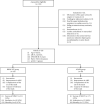Noninvasive Mechanical Ventilation with Average Volume-Assured Pressure Support versus BiPAP S/T in De Novo Hypoxemic Respiratory Failure
- PMID: 35966802
- PMCID: PMC9365614
- DOI: 10.1155/2022/4333345
Noninvasive Mechanical Ventilation with Average Volume-Assured Pressure Support versus BiPAP S/T in De Novo Hypoxemic Respiratory Failure
Abstract
Background: Bilevel positive airway pressure in spontaneous/time and average volume-assured pressure support (BiPAP·S/T-AVAPS) could maintain an adequate tidal volume by reducing the patient's inspiratory effort; however, this ventilatory strategy has not been compared with other ventilatory modes, especially the conventional BiPAP S/T mode, when noninvasive mechanical ventilation (NIMV) is used. The primary objective of this study was to determine the rate of success and failure of the use of BiPAP·S/T-AVAPS versus BiPAP·S/T alone in patients with mild-to-moderate "de novo" hypoxemic respiratory failure.
Methods: This was a matched-cohort study. Subjects with mild-to-moderate de novo hypoxemic respiratory failure were divided into two groups according to the ventilatory strategy used. The subjects in the BiPAP·S/T group were paired with those in the BiPAP·S/T-AVAPS group.
Results: A total of 58 subjects were studied. Twenty-nine subjects in the BiPAP·S/T group were paired with 29 subjects in the BiPAP·S/T-AVAPS group. Twenty patients (34.5%) presented with "failure of NIMV," while 38 (65.5%) patients did not. In addition, 13 (22.4%) patients died, while 45 (77.6%) recovered. No differences were found in the percentage of intubation (P=0.44) and mortality (P=0.1).
Conclusion: The BiPAP S/T-AVAPS ventilator mode was not superior to the BiPAP·S/T mode. A high mortality rate was observed in patients with NIMV failure in both modes. This trial is registered with https://doi.org/10.1186/ISRCTN17904857.
Copyright © 2022 Killen H. Briones-Claudett et al.
Conflict of interest statement
The authors declare that they have no conflicts of interest.
Figures
Similar articles
-
Noninvasive mechanical ventilation with average volume assured pressure support (AVAPS) in patients with chronic obstructive pulmonary disease and hypercapnic encephalopathy.BMC Pulm Med. 2013 Mar 12;13:12. doi: 10.1186/1471-2466-13-12. BMC Pulm Med. 2013. PMID: 23497021 Free PMC article. Clinical Trial.
-
Use of noninvasive mechanical ventilation with pressure support guaranteed with average volume in de novo hypoxaemic respiratory failure. A pilot study.Anaesthesiol Intensive Ther. 2018;50(4):283-290. doi: 10.5603/AIT.a2018.0036. Epub 2018 Oct 14. Anaesthesiol Intensive Ther. 2018. PMID: 30317536
-
Role of Average Volume Assured Pressure Support Mode (AVAPS) in the Management of Acute Exacerbation of Chronic Obstructive Pulmonary Disease With Type 2 Respiratory Failure.Cureus. 2022 Dec 5;14(12):e32200. doi: 10.7759/cureus.32200. eCollection 2022 Dec. Cureus. 2022. PMID: 36620824 Free PMC article.
-
Non-invasive ventilatory support and high-flow nasal oxygen as first-line treatment of acute hypoxemic respiratory failure and ARDS.Intensive Care Med. 2021 Aug;47(8):851-866. doi: 10.1007/s00134-021-06459-2. Epub 2021 Jul 7. Intensive Care Med. 2021. PMID: 34232336 Free PMC article. Review.
-
Biphasic positive airway pressure (BIPAP)--a new mode of ventilatory support.Eur J Anaesthesiol. 1994 Jan;11(1):37-42. Eur J Anaesthesiol. 1994. PMID: 8143712 Review.
Cited by
-
The role of the AVAPS ventilation mode combined with TCM monitoring in weaning patients with AECOPD.Sci Rep. 2025 Feb 8;15(1):4722. doi: 10.1038/s41598-025-89195-7. Sci Rep. 2025. PMID: 39922900 Free PMC article.
References
-
- Yarrarapu S. N. S., Saunders H., Sanghavi D. Average Volume-Assured Pressure Support . Tampa, FL, USA: StatPearls Publishing; 2022. - PubMed
LinkOut - more resources
Full Text Sources


